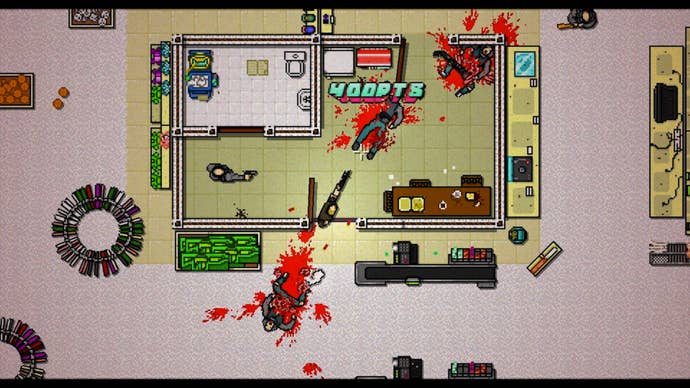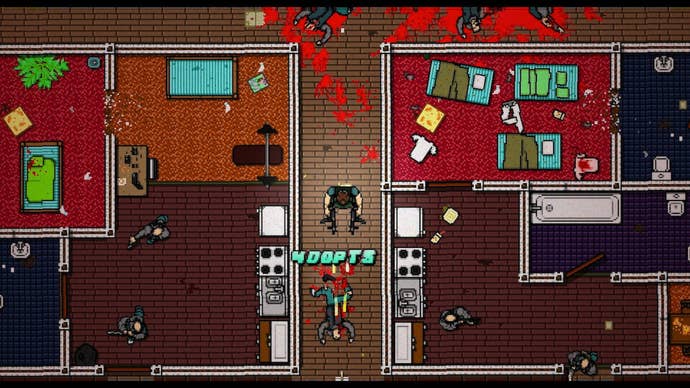Hotline Miami 2: Wrong Number PC Review: Redial
Dennaton's remix of their 2013 indie smash may not feel like a true sequel, but it still offers an interesting take on the original.
This article first appeared on USgamer, a partner publication of VG247. Some content, such as this article, has been migrated to VG247 for posterity after USgamer's closure - but it has not been edited or further vetted by the VG247 team.
On its surface, Hotline Miami resembles a parody of video games created by a mid-'90s sitcom writer's room: A veritable orgy of violence for violence's sake, painted in glorious 16-bit graphics and sold purely on shock value. Take a closer look, though, and you may notice a much smarter game than you'd think underneath all those pixelated entrails.
While the original Hotline Miami could have easily coasted on its attitude alone, this 2013 indie release seamlessly combined fast-twitch action with puzzle elements for a wholly unique experience that rightfully earned a glowing critical response. Thankfully, Dennaton's winning formula hasn't changed much: Like the original, Wrong Number tasks players with killing every enemy within a level, and while this usually occupies less than a minute, getting to the point where you can reach the end without ending up a bloody smear often takes much, much longer. Success only comes after you retry your plan of attack, step by meticulous step—though sometimes a reckless blitz into danger can be just as helpful.

While the first Hotline Miami gave players slight customization options by allowing them to choose from a variety of unlockable masks with specific bonuses, Wrong Number goes for a more prescribed approach by building levels around the strengths and weaknesses of the specific characters. Once again, Hotline Miami chooses to tell its story via the lens of psychedelic neo-noir, though, this time around, it's a bit more ambitious, bouncing between different years on a whim as details about its cast are delivered in fits and starts. While I assume it's at least possible to follow Wrong Number's story, I viewed it as existing for the sake of texture rather than necessity; typically, by the time your umpteenth try gets you to the end of a level, you'll have long forgotten the motivation that caused so much murder to happen in the first place. (But maybe that's the point?)
Some may not like how Wrong Number sticks players with a particular character per level—sometimes offering the choice of a minor variant—since a good deal of the original Hotline Miami's charm came in finding your favorite approach to mass murder. This change, though, has resulted in levels that feel much more thoughtfully designed, and even if some tend to drag on just a little too long, having to cope with the abilities of a new character constantly kept me on my toes. One of Wrong Number's cast refuses to kill, for instance, which makes guns completely useless, while another comes equipped with a powerful firearm that can only be resupplied (and can't be dropped) via limit ammo caches throughout a level. Whatever the case, each stage definitely feels designed with its character in mind, and while this may result in many situations where there's only one "right" way to proceed, figuring out the path to success remains highly rewarding.
Of course, figuring out the best use of Wrong Number's cast requires a lot of experimentation, since the game isn't too keen on teaching. One of the harder levels features a pair of characters, tethered by an invisible link a la Smash Bros.' Ice Climbers, and maps a ranged attack to one button and a melee attack to another. Since this configuration made aiming way more complicated than normal, I found myself completely stuck until I realized that gunfire—in this case—was better for drawing vulnerable enemies into an empty room than killing them outright. And when I needed to actually use the gun as intended, through some experimentation, I learned I could position the armed character in a doorway while the other (and killable) one hid safely behind a wall. If Wrong Number walked me through these very specialized and organic abilities, I doubt I'd feel as good as I did when they suddenly clicked in my brain.

Wrong Number offers a few tweaks here and there, though they're only really noticeable if you play both games back-to-back. In the sequel, kicked-open doors no longer hurt opponents—they only stun them—but killing enemies in general comes a lot easier: One hit from a weapon eliminates them immediately, which means you won't have to follow up your attacks with time-consuming finishers. Dennaton hasn't deviated one bit from Hotline Miami's hideously beautiful art style, though; in the sequel, it's even more rich with gruesome detail and eye-searingly trippy graphical effects. And they've doubled down on the soundtrack as well, combining tracks from several notable artists that manage to be effective but don't wear out their welcome after your thirtieth attempt at a level. It's a collection of songs that's definitely going to accompany my writing duties for months to come.
Even though I enjoyed my time with Hotline Miami 2—after getting burned out a few hours into the original—I can't say it fully justifies its status as a sequel. While the wide-ranging cast provides plenty of unique challenges, I still get the feeling there's so much left to be done in this world, especially in terms of storytelling—it so often exists outside of gameplay, the few times it doesn't feel special. Still, Dennaton managed to think of a way to refurbish their winning formula in a fashion that kept me going long after I should have been frustrated into submission. I'm not sure if the essentials of Hotline Miami are strong enough for another sequel of this type, but, as it stands, Wrong Number is an admirable—and smarter—take on the original's gory mayhem.
VisualsThe stomach-churning pixel art you've come to expect is back, and this time, with extra-gory details.
SoundHotline Miami's reputation for having a stellar soundtrack hasn't changed—this time around, it might be even better.
InterfaceThough the rules of the world aren't as consistent as they could be, Wrong Number nevertheless empowers you to perform several superhuman feats within the span of a few seconds.
Lasting AppealWeighing in at about 12-15 hours, Wrong Number makes for a much longer experience than the original—and mastering every level can easily double or triple this number.
ConclusionWrong Number might not be the ambitious sequel you're expecting from Hotline Miami, but if you enjoyed the original, the way Dennaton plays with its essential formula makes for a worthwhile experience.
